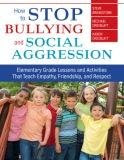Press Release: Manchester, VT
Back-to-school season is filled with anxieties about new teachers, increased workloads and, often, how to avoid the dreaded classroom bullies.
Although boys have the reputation of being more physical and girls more verbal, all children have the potential to bully physically, verbally, socially, and through the use of technology (cyber-bullying). Although bullying peaks between fifth grade and ninth grade, it is reported at all ages.
“Today, bullying frequently involves mean words, starting rumors or excluding a classmate from a certain clique,” said Steve Breakstone, co-founder of Balance Educational Services and co-author of the new book, How to Stop Bullying & Social Aggression: Elementary Grade Lessons and Activities That Teach Empathy, Friendship, and Respect.
“Ongoing bullying can lead to low self-esteem, criminal activity, domestic violence, suicide, and other self-destructive behaviors,” Breakstone continued.
“Bullying has been the root cause of a number of recent school shootings, including the terrifying incident at Columbine High School,” said Michael Dreiblatt, co-founder of Balance Educational Services and co-author of How to Stop Bullying & Social Aggression.
“The truth is that school violence is on the rise, and our educators and parents have to be pro-active about identifying – and modifying – bullying behavior,” Dreiblatt continued.
School administrators, teachers and staff should look for “warning signs” that students are bullying or being bullied, including:
- Diminishing grades
- Increased absenteeism
- Few friends and social networks
- Changes in attitude towards school, schoolmates and adults.
Parents of bullies may notice some of the following behaviors in their child:
- A need to dominate friends, schoolmates and siblings
- Bragging about superiority over others
- Oppositional, defiant, and aggressive behavior toward adults, including teachers and parents.
Parents of bullied children will notice major behavioral changes in their children, including:
- Personality
- Wardrobe
- Make-up
- Eating habits
- Sleeping patterns
- Anxiety levels
- Time spent alone
- Amount of time spent crying
- Other dramatic changes.
Important strategies to stop bullying in school include:
- Creating a school-wide “same page” understanding of what bullying behavior includes
- Teaching all staff to consistently respond to all bullying behaviors (i.e. “nip it in the bud”
- Teaching pro-social behaviors such as respect, empathy, and assertiveness
- Teaching and practicing pro-social skills
- Increasing adult supervision, especially in unstructured areas of the school.
- Providing appropriate role-models to teach bullies and targets new behaviors.
Bullying, if not handled correctly during the formative years, frequently leads to long-term problems in both the bully and the target. Bullying not only undermines a child’s self-worth but also makes the target feel intimidated, threatened, unsupported, and unsafe. Bullies are more likely to use alcohol and drugs, as well as face legal or criminal problems later in life. Targets often suffer from anxiety, depression, lack of focus and low self-esteem. These behaviors can also seep into the adult years and affect workplace interactions.
Research shows that schools with a unified violence prevention program cut their incidents of violence up to 70 percent and increased their academic standing. Visit http://www.balanceeducationalservices.com/ to learn more solutions to Stop Bullying Now!



No comments:
Post a Comment